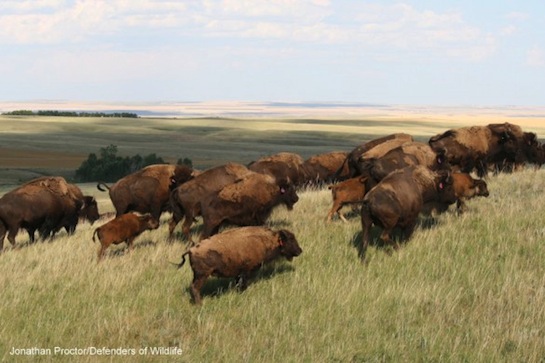
In Montana, the Assiniboine & Sioux Tribes’ new herd of bison was caught in the line of a September wildfire. Photo Courtesy/Jonathan Proctor
Montana wildfire hinders tribes’ buffalo recovery efforts
By Talli Nauman
Native Sun News
Health & Environment Editor FORT PECK, Mont. — A 14,000-acre wildfire on Fort Peck Reservation in northeastern Montana burned through the tribal buffalo range, leaving 10 dead bison in its wake, Defenders of Wildlife communications associate John Motslinger said Sept. 17. Earlier reports on the so-called Brookman fire put the bison fatality count at two, after the Sept. 11 and 12 blazes swept through most of the 2,100-acre range where the bison were grazing. “It’s heartbreaking to lose these 10 bison after the tribes at Fort Peck have waited so long and worked so hard for their return,” said Defenders of Wildlife bison expert Jonathan Proctor. The casualties were among 82 genetically pure bison the Assiniboine & Sioux Tribes at Fort Peck procured from their original home in Wyoming’s Yellowstone National Park earlier this year. Proctor, in collaboration with Fort Peck’s Fish & Game Department Director Robbie Magnan, said the rest of the herd will be moved to another range while tribal wildlife managers rebuild the charred pasture’s fence. The recently reintroduced herd consisted of 61 adults and 21 calves. “Sadly, eight adult bison and two calves died in the fast-moving fire or were put down as a result of injuries caused by the fire,” Motslinger said. The cause of the fire is unknown. It apparently started a few miles west of the bison pasture along a county road connecting Scobey and Wolf Point, two rural outposts on the high, windy plains, where gusts reaching 40 mph fanned the flames. “Fort Peck Fish & Game will have their work cut out for them,” Motslinger said. They must quickly rebuild the fence that was completed less than two months ago, he said. The adult bison were transferred to the reservation in March from a quarantine facility outside of Yellowstone, where some of them had been held for more than five years as part of a herd restoration effort to provide genetically pure bison stock. They were then kept in a corral at Fort Peck, where the calves were born this spring. In July, all of them were released from a temporary enclosure onto the range. Fort Peck has plans to open an additional 5,000 acres this fall for the bison herd to grow into the hundreds. The plans call for giving about half of the bison to the Fort Belknap Reservation in northern Montana, once fencing is completed there. Defenders of Wildlife have helped contribute funds in the past for bison fencing at Fort Peck and for the transport of genetically pure bison to the reservation. Proctor said the organization is committed to assisting with recovery. “This tragic fire is not the end of bison restoration at Fort Peck,” he said. “We’re determined to do everything we can to help the tribes move forward with their restoration program as planned.” (Contact Talli Nauman at talli.nauman@gmail.com)
Join the Conversation